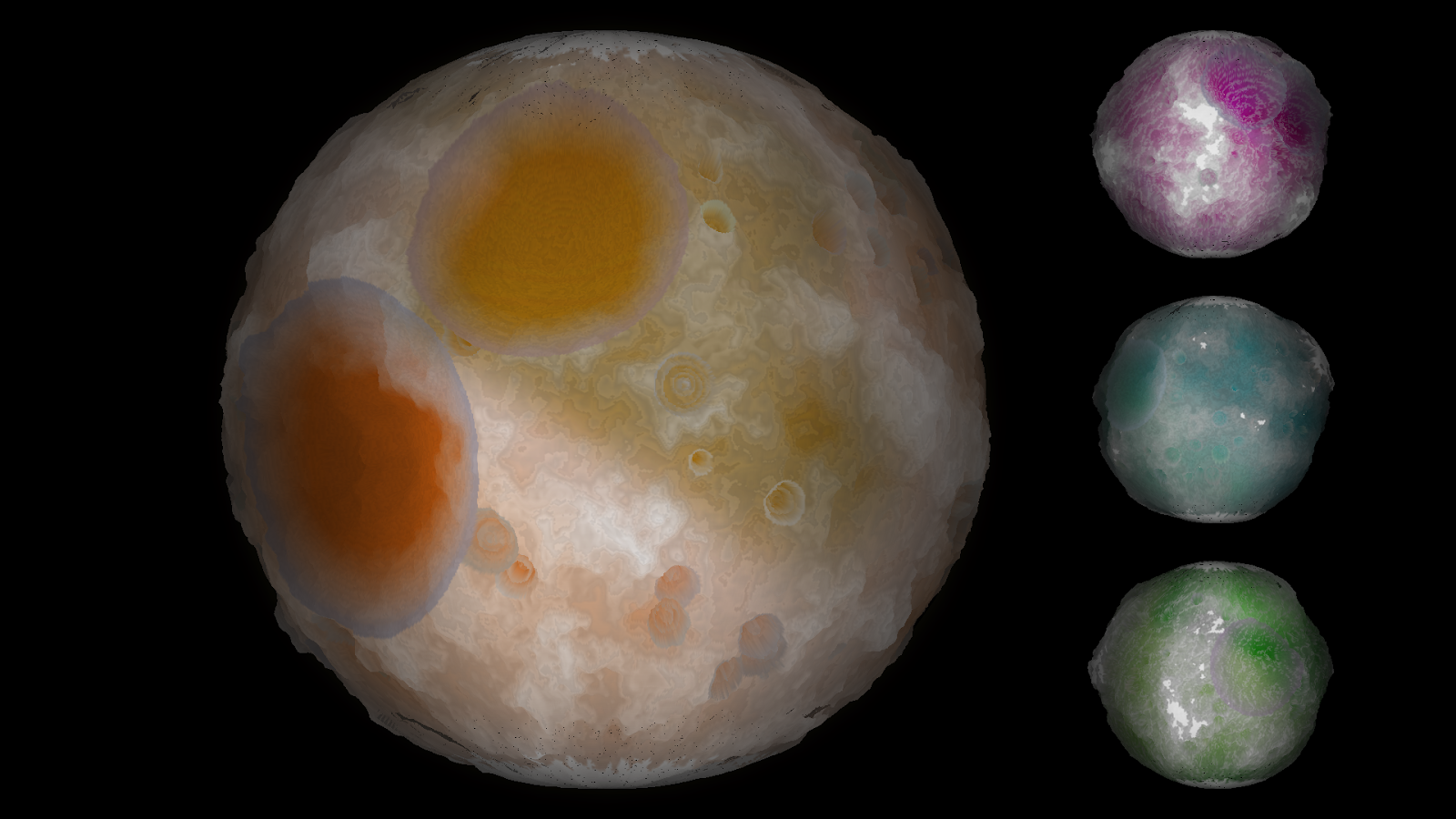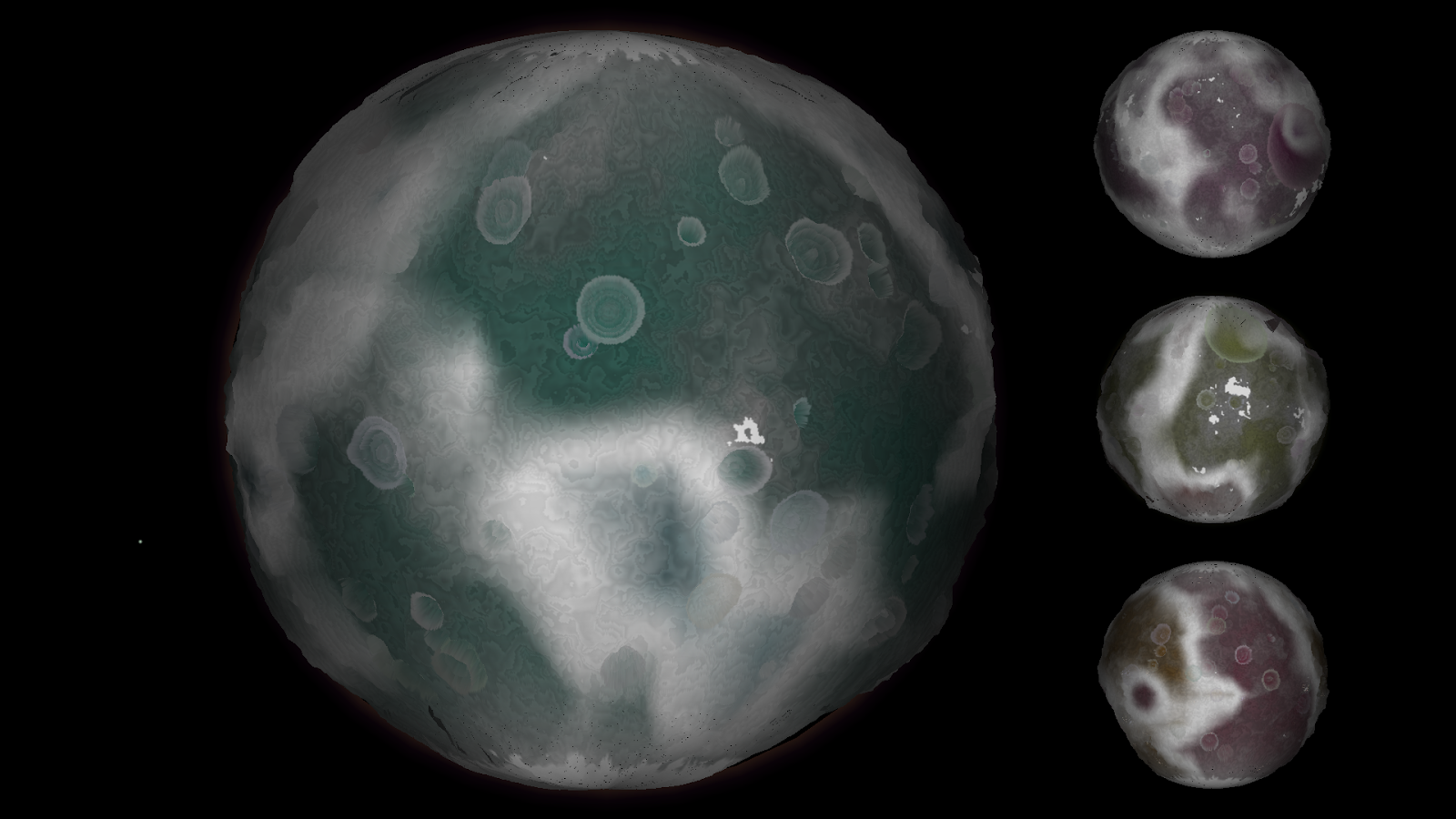This is a continuation of Planet Zoo, where I will give a more in-depth look at several instances of each planet type, to show the variation between planets of the same type.
(EDIT: Some of these pictures have now been moved to the original article)
Terra
Terra planets are made to look like Earth. Half their surface is hidden beneath deep blue oceans. The other half ranges in colour from arid sand to humid forests. They have ice at the poles and at the top of mountains. Their terrain forms continents and islands, a balance between high and low frequencies. They have an atmosphere and clouds, though my implementation of clouds still leaves something to be desired.
Exo
These planets are alien versions of Terra planets. Their seas take on a random hue, and their biomes have their colours shifted randomly away from the yellow-to-green of Earth. Depending on planet, they may have continents, but not always - sometimes, the terrain has a much higher frequency. Really, almost everything is random.
They, in fact, are so random, I think I'd better show off another example. The middle planet on the right, for instance, is very interesting. Also, this new batch allows us to see that some Exo planets have atmospheres and clouds.
Rust
This type of planet mimicks Mars or Mercury - dry, terrestrial planets. They may be colourful or dull, but are mostly monochromatic. On some, we also see a scaly pattern, that many of them take on, just to make them more interesting to look at. Some are mostly flat, while others are rough, with high mountains that stretch far into space. They have no atmosphere and are marred by asteroid impacts, often big.
Marble, subtype of Rust
This type of planet has a fixed colour palette - light lines seperating dark areas of two different colours. This system is the very same used for the "biomes" of Terra planets, just to show how effectful a simple randomly applied colour palette can be.
Gas
Gas giants are big, smooth planets. Inspired by Jupiter, they have long lines drawn across their surface in the direction of rotation. Once more, this is the same system as biomes on Terra and the marbly areas on Marbles, only where the Perlin noise has been stretched horizontally.
Colours are picked from vibrant hues all throughout the spectrum. They often have meteorite rings around them, though not showcased in this post.
Cask, subtype of Gas
Cask planets have softer stripes than normal Gas planets, but instead they have a fine web drawn across their surface with a complimentary colour to the rest of their surface.
Rock
Rocks are hardly planets at all, more inspired by asteroids and meteors. To this end, their terrain is even more chaotic, and is drawn as large bumps to the spherical form of the planet. Their colour is dull, but just as jumbled. Their surface is wrecked by impact sites, which make their profile even more uneven.
Metal, subtype of Rock
These are a palette swap for Rock planets, where half the planet is in dull, rocky colours, and the other half in a stark, strong colour, meant to look like dark metal. That the above collections have a lot of snow-tipped mountains is just random chance, I think.
Seed, subtype of Rock
Inspired by the theory of panspermia, that life might travel from planet to planet on meteors, these Seeds are meant to be as small as an asteroid, but have thriving oceans nonetheless. I know that in real panspermia, life would probably be much less apparent, and I seriously doubt that water could be liquid on such small celestial bodies. This is not that relevant, though.
Magma
This type of planet goes a bit beyond just recolouring the oceans red. The land is made dark and more high-frequency. The oceans are fiery, shining so they can be seen from the dark side of the planet. This is not as apparent in this non-animated form, but I promise, I promise. They also still have those gigantic impact sites, being young planets and all, but it looks quite different now that impacts are filled with, well, lava here.
Sulphur, subtype of Magma
Again, a palette swap. The oceans are yellow instead, like molten sulphur, and the land takes on warm, blue and green colours, mimicking other rarer colours of sulphur.
Ice
Well, they should be white, should they not? How do you make white planets interesting?
Ice planets have snow-tipped mountains with a very low snow-point, and the oceans, as well, are white. Where they are free of snow, the colours need to be pale to not have too stark a contrast. Still, those are the places where one can make the generation interesting. Here, I use the same web as showcased on the Cask-type planets. The web was originally developed for the ice-planets though. Additionally, the web can also be seen in the snow, making the white parts a bit more interesting, though with much more faded colours.
Crystal, subtype of Ice
Crystal planets are more colourful varieties of ice planets. They also have sparkling rainbow oceans, which look much better when animated.
And that's it. Those are the planet types that I have made up, but there are still a lot more ways of combinining colours and textures.
(EDIT: Some of these pictures have now been moved to the original article)
Terra
Terra planets are made to look like Earth. Half their surface is hidden beneath deep blue oceans. The other half ranges in colour from arid sand to humid forests. They have ice at the poles and at the top of mountains. Their terrain forms continents and islands, a balance between high and low frequencies. They have an atmosphere and clouds, though my implementation of clouds still leaves something to be desired.
Exo
These planets are alien versions of Terra planets. Their seas take on a random hue, and their biomes have their colours shifted randomly away from the yellow-to-green of Earth. Depending on planet, they may have continents, but not always - sometimes, the terrain has a much higher frequency. Really, almost everything is random.
They, in fact, are so random, I think I'd better show off another example. The middle planet on the right, for instance, is very interesting. Also, this new batch allows us to see that some Exo planets have atmospheres and clouds.
This type of planet mimicks Mars or Mercury - dry, terrestrial planets. They may be colourful or dull, but are mostly monochromatic. On some, we also see a scaly pattern, that many of them take on, just to make them more interesting to look at. Some are mostly flat, while others are rough, with high mountains that stretch far into space. They have no atmosphere and are marred by asteroid impacts, often big.
Marble, subtype of Rust
This type of planet has a fixed colour palette - light lines seperating dark areas of two different colours. This system is the very same used for the "biomes" of Terra planets, just to show how effectful a simple randomly applied colour palette can be.
Gas
Gas giants are big, smooth planets. Inspired by Jupiter, they have long lines drawn across their surface in the direction of rotation. Once more, this is the same system as biomes on Terra and the marbly areas on Marbles, only where the Perlin noise has been stretched horizontally.
Colours are picked from vibrant hues all throughout the spectrum. They often have meteorite rings around them, though not showcased in this post.
Cask, subtype of Gas
Cask planets have softer stripes than normal Gas planets, but instead they have a fine web drawn across their surface with a complimentary colour to the rest of their surface.
Rock
Rocks are hardly planets at all, more inspired by asteroids and meteors. To this end, their terrain is even more chaotic, and is drawn as large bumps to the spherical form of the planet. Their colour is dull, but just as jumbled. Their surface is wrecked by impact sites, which make their profile even more uneven.
Metal, subtype of Rock
These are a palette swap for Rock planets, where half the planet is in dull, rocky colours, and the other half in a stark, strong colour, meant to look like dark metal. That the above collections have a lot of snow-tipped mountains is just random chance, I think.
Seed, subtype of Rock
Inspired by the theory of panspermia, that life might travel from planet to planet on meteors, these Seeds are meant to be as small as an asteroid, but have thriving oceans nonetheless. I know that in real panspermia, life would probably be much less apparent, and I seriously doubt that water could be liquid on such small celestial bodies. This is not that relevant, though.
Magma
This type of planet goes a bit beyond just recolouring the oceans red. The land is made dark and more high-frequency. The oceans are fiery, shining so they can be seen from the dark side of the planet. This is not as apparent in this non-animated form, but I promise, I promise. They also still have those gigantic impact sites, being young planets and all, but it looks quite different now that impacts are filled with, well, lava here.
Sulphur, subtype of Magma
Again, a palette swap. The oceans are yellow instead, like molten sulphur, and the land takes on warm, blue and green colours, mimicking other rarer colours of sulphur.
Ice
Well, they should be white, should they not? How do you make white planets interesting?
Ice planets have snow-tipped mountains with a very low snow-point, and the oceans, as well, are white. Where they are free of snow, the colours need to be pale to not have too stark a contrast. Still, those are the places where one can make the generation interesting. Here, I use the same web as showcased on the Cask-type planets. The web was originally developed for the ice-planets though. Additionally, the web can also be seen in the snow, making the white parts a bit more interesting, though with much more faded colours.
Crystal, subtype of Ice
Crystal planets are more colourful varieties of ice planets. They also have sparkling rainbow oceans, which look much better when animated.
And that's it. Those are the planet types that I have made up, but there are still a lot more ways of combinining colours and textures.














Comments
Post a Comment